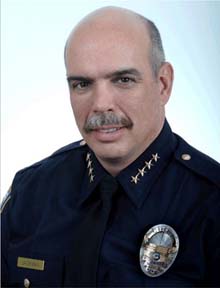|
By Jorge Casuso
October 12 -- Police Chief
Tim Jackman pulled out a map of Santa
Monica coded to show where calls for
service are concentrated – ranging
from blue for the fewest calls to
red for areas where most of the reports
originate – and pointed to a
flaring red blotch.
That hot spot, he said, encompasses
the heart of Downtown Santa Monica,
and it’s surrounded by an island
of orange, where the second highest
concentrations of calls can be found.
 |
“Downtown
generates the most police activity
in the city,” said Jackman.
“It’s an indication
of where most people are and most
conflict. The Promenade drives
a lot of that. It’s just
a very busy area.”
The computer-generated map is
part of the state-of-the-art technology
the chief is using to combat crime.
The other – more traditional
method – is the shiny black
shoes on his feet.
Since accepting Santa Monica’s
top law enforcement post ten months
ago, the chief has become a visible
presence, strolling the streets
of the city in his navy blue uniform
decorated with stripes and badges,
waving to passersby, stopping
to chat with shop owners. |
“I still walk quite a bit,
as much as I can,” said Jackman,
whose strolls still draw smiles, waves
and stares. “If I’m Downtown,
I try to walk.
“It’s very nice,”
he said. “When I walk on Fourth
Street, every other car seems to honk
and wave.”
After his concentrated efforts on
the Downtown and Pico Neighborhood,
he has now walked much of the 8.3
square-mile city, rolled up his sleeves
and is restructuring the existing
police beats to reflect the distinct
areas of the city.
One thing he hopes Santa Monicans
will see more of are cops walking
their beats to get the pulse of the
city’s business strips and neighborhoods.
“More important than seeing
me is seeing police officers out there,”
said Jackman, who was Deputy Police
Chief in Long Beach before coming
to Santa Monica. “We’re
pushing a strategy that’s bottom
up.”
It didn’t take walking the streets
to quickly learn that the key issues
facing the Downtown remain the homeless
and traffic, two of the three top
concerns (the other being youth and
gang violence) that top one resident
survey after another.
“We’ve had several fatal
accidents Downtown,” he said.
“The traffic issues are huge.
Congestion is a big deal… We’re
working together with traffic management
to see what we can do. Having officers
handle traffic is expensive.
“We’re pushing a lot of
public transportation, trying to make
that work,” Jackman said. “It
presents some unique challenges.”
While traffic doesn’t seem to
be getting better, there does seem
to be fewer homeless people on Santa
Monica’s streets, which could
be the result of moving the programs
that handed out free meals in the
parks indoors, Jackman said.
Perhaps the best way to handle the
homeless problem is with “tough
love” – making arrests
for bad behavior – much of it
“low-level quality of life stuff”
– but also offering services
that help get people off the streets.
“People want to be compassionate,
but they don’t want anti-social
behavior,” Jackman said. “We’re
making sure than if an illegal act
is done, we’re taking sufficient
action. No one wants to go to County
Jail. So long as that continues to
work, that’s what we’ll
continue to do.”
Raised mainly by his mother and grandparents
in rural New Hampshire, Jackman recalls
there wasn't much to get into trouble
over in a town of 1,500 best known
for its dairy production.
“It was a small community,”
said Jackman. “If you ever had
any thoughts of doing anything wrong,
your neighbors would rat you out in
a heartbeat.”
The career law enforcement officer
spent the second half of his life
fighting crime. After a stint in the
Marines – enlisting at age 17
to find some "discipline"
– Jackman fell into police work
in Long Beach for 23 years. He spent
most of the first ten patrolling the
city’s toughest streets.
With a B.S from the University of
the State of New York and an M.B.A
from U.C. Irvine, Santa Monica’s
new chief, who quickly put his own
stamp on the job, believes a “collaborative”
approach is the best way to fight
crime.
“I don't think we have all the
answers,” he said shortly before
assuming his new job. “Sometimes
I think the public can come up with
answers we don't see. A lot of police
work is common sense. What I'm looking
for, is a community that is talking.”
|